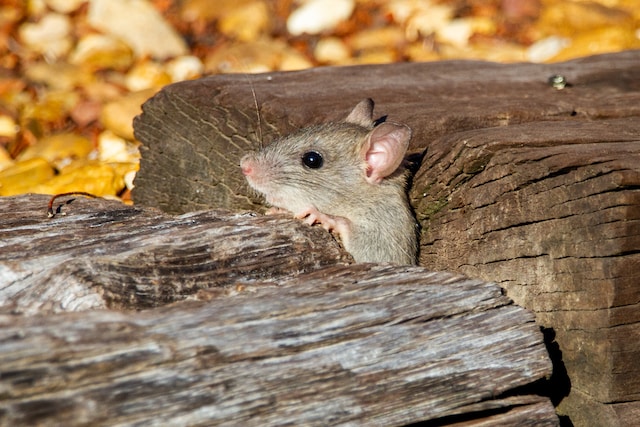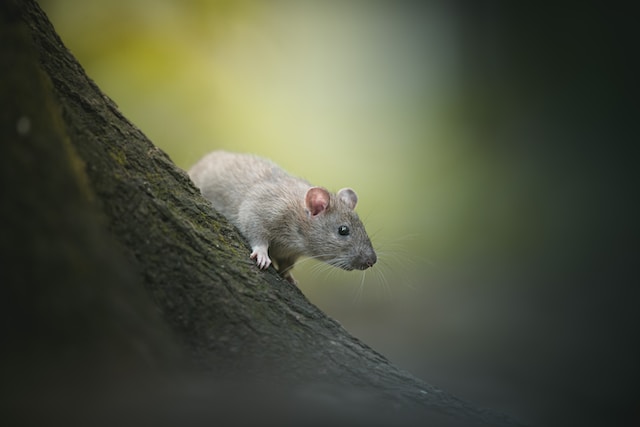Ready to take on your rodent invasion? What’s the difference between mice and rats? Knowing the key differences between rats and mice is crucial to determining your next action.
From their telltale physical characteristics to their behavior and lifespan, understanding what sets rats and mice apart will help you confidently tackle your infestation.
So let’s dive into the nitty-gritty of these tiny terrors to understand what’s the difference between mice and rats and get the upper hand on your pest problem.
Everything to Know About Rats
Norway rats, also known as brown rats, burrow in underground dens or structures near the ground. They are heavy-bodied and have shaggy fur, usually brown or gray.
Roof rats, also known as black rats, are agile climbers that typically live in higher locations, such as trees or attics. They are more petite and slender than Norway rats, with glossy black fur and a long tail.
Predominantly known for their excellent climbing abilities, roof rats are usually spotted in high, hard-to-reach spaces and can enter buildings through holes or gaps in roofs, eaves, or walls.
Both Norway rats and roof rats are omnivores and will eat a wide range of foods, including pet food, seeds, fruits, and vegetables. They will also gnaw on materials like plastic, wool, leather, and wooden structures, causing significant damage to buildings.
Handling a Mice Infestation
Still curious about what’s the difference between mice and rats?
Like rats, mice are located worldwide and predominantly in New York. While they don’t reproduce as quickly as rats, these pests can still swiftly overrun commercial and residential buildings.
Because of their small stature and decent climbing skills, they can enter most structures, no matter how slight or high the opening.
Check out this video to see how small of spaces a mouse can squeeze through!
Mice often seek out food and shelter indoors, often to the detriment of homeowners. A mice infestation can cause issues in your home as these pests spread bacteria, contaminate food, and damage essential household items.
.
What’s the Difference Between Mice and Rats?
Size is one of the most noticeable differences between mice and rats. Mice are generally smaller, typically growing to about 4 to 7 inches in length, while rats are larger, with some common species reaching almost 18 inches long.
Because of their significant size differences, you may also notice distinctions in how the rodents impact your home. Both will eat almost anything indoors, but mice are more likely to feed on smaller, more readily available food sources on your countertops or inside your pantry.
Mice are also more likely to inhabit indoor spaces, seeking areas with warm shelter and frequent access to food. Rats also occupy households, but you’re more likely to find them outdoors in alleyways, sewers, or underground burrows than the average house mouse.
While rodents are typically wary of humans, rats are more likely to stay away from your household inhabitants. These pests are highly cautious and won’t venture too far from their nesting location.
Mice aren’t as shy! A mouse won’t openly approach you unless domesticated, but mice will still sneak around heavily-trafficked spaces. You may see one of these tiny pests running across your floor as you watch tv or scamper around your kitchen as you clean!
Disease transmission is a shared concern between both mice and rats. All rodents can damage buildings, destroy household items, and spread bacteria through their waste. However, rats are slightly more aggressive, meaning accidental encounters are more likely to turn dangerous.
In fact, during isolation periods or times without easy access to food, rats may act out or even try to eat one another. Avoid hungry rodents at all costs, and focus on pest control methods to keep your home safe!
Mice and Rat Pest Control
What’s the difference between mice and rat pest control methods?
When dealing with rodents, there aren’t many differences in how to handle an infestation. You may have to employ various methods based on their size and the infestation location, but you can still rely on similar products to keep mice and rats at bay.

Before beginning any extermination efforts, identify and eliminate food sources and nesting areas. Stored food is a common target for rodents, but you should also check anything in flimsy packaging for signs of wear.
Thick plastic or glass containers should help eliminate the threat of rodents in your kitchen. Opt for these sturdy materials instead of leaving your goodies in their original paper-thin wrapping and boxes.
Cluttered areas can house mice or rats, especially in secluded locations. You can often find signs of mice in storage boxes or attics by torn fabric, insulation, paper, and the presence of droppings.
Don’t forget about how rodents enter your home, either! Exclusion efforts are vital to prevent mice and rats, but you’ll also want to focus on repairing door and window gaps or holes in your home’s foundation, walls, or roof.
Of course, these options won’t stop an active infestation. You’ll need targeted products and treatments to remove the pests and prevent them from breeding.
Baited snap and glue traps are popular for mice infestations, with the former product quickly eliminating pests with little fuss. Glue traps entrap live mice until you empty or throw away the trap.
Glue traps won’t cut it for larger rat species, as they can wiggle free of the sticky substance with a bit of work. Oversized snap traps are suggested when handling larger-sized rodents.
Before using a spring or snap trap, remember to position the trigger correctly and follow all of the label’s instructions. Check on these traps regularly and place them in spots where children and pets can’t interact with them.
Similarly, when using bait, choose a bait that is appropriate for the species you are dealing with and place it in a location inaccessible to children, pets, or non-target animals.
If you’re queasy about the prospect of handling these tiny pests, don’t worry. We have your back!
Eliminating rodents on your own is tricky and not for the faint of heart. We recommend relying on a reputable pest control expert like United States Pest Service to finish the job quickly.
No matter the rodent, we’ll eliminate them quickly and remove the disease-causing pest from your home. Contact us today to schedule a pest control appointment with our talented and experienced specialists!

